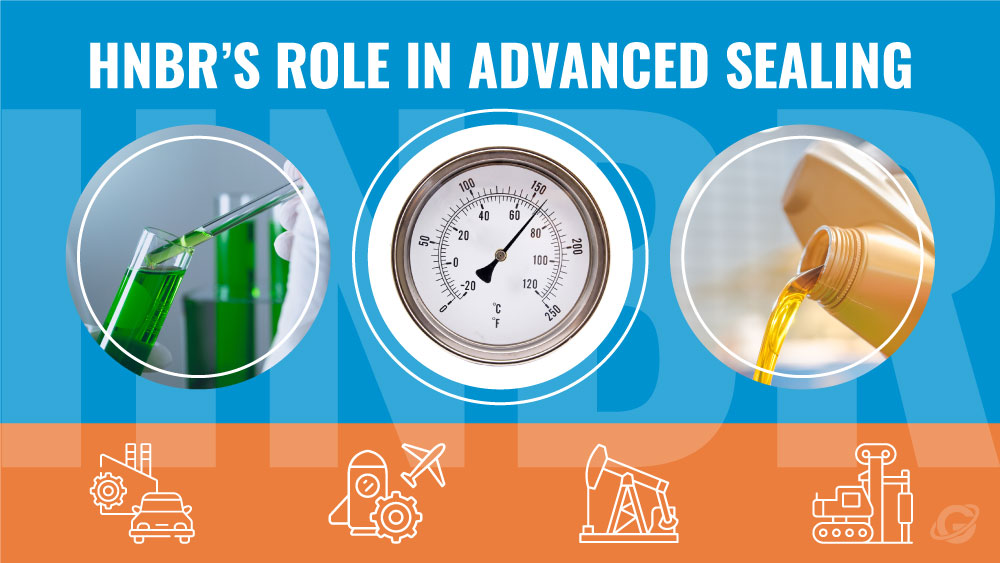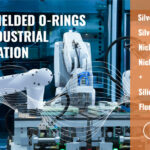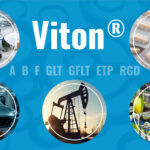
Summary
- Hydrogenated Nitrile Butadiene Rubber (HNBR) is a pivotal material in industries, offering superior resistance to high temperatures, oils, and chemicals, enhancing operational safety and efficiency.
- HNBR’s unique properties include excellent thermal stability, oil and chemical resistance, and mechanical strength, making it ideal for demanding automotive, aerospace, oil and gas, and heavy machinery applications.
- Despite its robustness, understanding HNBR’s limitations and proper application is crucial for optimal performance, ensuring longevity and reliability in various industrial settings.
Introduction
In the dynamic and ever-evolving world of industrial applications, the quest for materials that combine durability, resilience, and versatility has led to significant scientific advancements. One such breakthrough is the development of Hydrogenated Nitrile Butadiene Rubber (HNBR), a material that has revolutionized how industries approach sealing and longevity in harsh environments. This blog post explores the fascinating world of HNBR, its inception, material characteristics, applications in high-temperature environments, and its indispensable role in the field.
Overview of HNBR O-Rings

Hydrogenated Nitrile Butadiene Rubber (HNBR), a significant advancement from its predecessor Nitrile Butadiene Rubber (NBR), stands as a testament to the strides made in material science over recent decades. An industry-wide quest for materials that could withstand more demanding environments, specifically those with extreme temperatures, oils, and chemicals, resulted in the inception of HNBR. HNBR emerged as a robust and versatile elastomer characterized by its enhanced molecular structure that offers superior resistance and mechanical strength. As industries continue to evolve and face new challenges, the role of HNBR is likely to expand, driven by its proven track record and ongoing enhancements.
Continuous improvements and technological advancements marked the historical journey of HNBR o-rings. Originating from NBR, HNBR was developed to address the limitations faced by its predecessor, particularly in terms of temperature resistance and longevity. While useful in various applications, NBR struggled under extreme conditions, leading researchers to seek a more resilient material. The breakthrough came with the hydrogenation process, where unsaturated bonds of NBR’s butadiene segments were selectively hydrogenated, significantly enhancing the material’s thermal stability and strength. This process marked a turning point, resulting in a rubber that could withstand much harsher conditions.
Over the years, continuous advancements have been made to the formulation and processing of HNBR, improving its properties and expanding its applicability. These developments were in response to the demanding conditions of the oil and automotive industries and the anticipated needs of emerging technologies and sectors. Enhancing the ability to resist ozone, oxidation, and various chemicals and broaden the temperature range was pivotal in transitioning HNBR from a specialized solution to a mainstream choice for numerous applications.
The adoption of HNBR is most notable in sectors where reliability and performance under stress are non-negotiable. In the automotive industry, it’s a material of choice for sealing solutions with engines, transmissions, and fuel systems, where it must endure fluctuating temperatures and exposure to oils and fuels. Similarly, HNBR’s resistance to harsh chemicals and extreme conditions makes it indispensable for sealing components in drilling equipment and pipelines in the oil and gas sector. Beyond these, its presence is also significant in aerospace, manufacturing, and pharmaceuticals, among other fields, where its unique properties ensure safety and efficiency.
The advantages of using HNBR in industrial applications are clear and impactful. Its exceptional durability under high temperatures and in the presence of oils and chemicals reduces the need for frequent replacements and maintenance, ensuring operational continuity and safety. The material’s robust mechanical properties, including excellent tensile and tear strength, make it suitable for various dynamic and static applications. Additionally, the economic benefits of HNBR, due to its longevity and reduced maintenance needs, make it a cost-effective solution for many industries.
Characteristics of HNBR O-Rings
HNBR is a material lauded for its exceptional properties, making it suitable for various demanding applications. The distinctive characteristics of HNBR are intrinsically linked to its unique chemical composition, which explains its superior performance in various conditions. Understanding the material attributes of HNBR provides insights into its versatility and suitability for challenging industrial applications.
HNBR is a hydrogenated version of NBR. The hydrogenation process significantly reduces the number of double bonds in the butadiene component of NBR, resulting in a saturated backbone structure. This saturation is crucial, imparting HNBR with enhanced stability and resistance properties. The degree of hydrogenation directly affects the material’s properties, with higher levels typically yielding better resistance to heat and chemicals.
The hydrogenated backbone of HNBR provides remarkable thermal stability and heat resistance. Unlike many other rubbers, HNBR can withstand prolonged exposure to temperatures ranging from -40 °F (-40 °C) to +302 °F (+150 °C) and even higher for short periods, depending on the formulation, making it an excellent material for applications involving high-temperature fluids and gases. Stability at elevated temperatures is crucial in preventing degradation, maintaining seal integrity, and ensuring the longevity of components.
The saturated nature of HNBR’s structure enhances its resistance to oils, fuels, and various chemicals. Unlike unsaturated rubbers, the lack of double bonds prevents the material from readily reacting with or being broken down by aggressive substances. The resistance is particularly beneficial in the automotive and oil and gas industries, where seals and components must endure exposure to harsh fluids without swelling, cracking, or degrading, ensuring reliable performance and safety.
HNBR exhibits excellent mechanical properties, including high tensile strength and tear resistance due to its polymer chain’s saturation and the potential for cross-linking within the material. The strong covalent bonds and the uniform structure resist physical stresses, making HNBR ideal for dynamic applications where components will likely experience stretching, compression, and other forces. The material’s ability to maintain its integrity under stress contributes to the durability and reliability of the seals and components made from HNBR.
HNBR maintains a low compression set, meaning it can return to its original shape after being compressed, which is critical for maintaining an effective seal over time. The material’s elasticity is essential in applications where seals must repeatedly adapt to varying pressures and temperatures without losing their sealing capabilities. This resilience helps prevent leaks, minimizes maintenance requirements, and extends the service life of the components.
The combination of thermal stability, chemical resistance, and mechanical strength makes HNBR exceptionally long-lasting and durable, even in harsh industrial environments. It resists degradation from external factors like ozone, sunlight, and extreme weather conditions, maintaining its performance over time. This longevity is critical in reducing the need for frequent replacements, lowering operational costs, and minimizing downtime in critical applications.
While HNBR is a versatile and robust material, it’s essential to acknowledge its limitations. For instance, it may not perform as well in extremely low temperatures compared to some specialized materials. Additionally, certain aggressive chemicals and conditions can still affect HNBR, especially if not correctly formulated for the specific environment. Therefore, understanding the specific application requirements and potential exposure conditions is crucial when selecting HNBR for a particular use.
High-Temperature Applications of HNBR O-Rings

HNBR o-rings have become a cornerstone in industries where high-temperature applications are prevalent. Their unique properties make them indispensable in maintaining system integrity and ensuring safe and efficient operations. Understanding how HNBR o-rings function under these extreme conditions provides insights into their critical role in various industrial sectors.
High-temperature applications are widespread across numerous industries, including automotive, aerospace, oil and gas, and manufacturing. In the automotive sector, HNBR o-rings are essential for engine seals, transmission systems, and fuel injectors, where they encounter high heat and aggressive fluids. The aerospace industry relies on them for hydraulic systems and engine components that must perform reliably at elevated temperatures. Similarly, drilling equipment, pumps, and valves in oil and gas operations use HNBR o-rings, where seal exposure to high thermal and chemical stresses is likely. In manufacturing processes, such as chemical production and power generation, these o-rings ensure machinery and containment systems’ safe and efficient functioning.
HNBR o-rings are pivotal in maintaining the integrity of systems operating under high temperatures. They provide reliable seals that prevent leaks, resist degradation, and maintain their elastic properties even when exposed to prolonged heat. The ability of HNBR o-rings to withstand harsh conditions while retaining their shape and functionality is crucial in preventing system failures, minimizing downtime, and ensuring continuous operation. Their performance directly impacts the safety, efficiency, and longevity of the equipment and processes they are part of.
High temperatures can significantly affect the performance of sealing materials. Prolonged exposure can lead to hardening, loss of elasticity, and even degradation, compromising the seal and leading to failures. However, HNBR o-rings counter these effects. Their enhanced thermal stability means they can operate effectively in temperatures ranging from -40°C to 150°C and sometimes even higher for short periods. The hydrogenation process that HNBR undergoes increases its resistance to thermal degradation, allowing it to maintain its mechanical properties and sealing capabilities even under extreme heat.
In high-temperature operations, the safety of both personnel and equipment is paramount. A failure in a sealing component can lead to leaks, spills, or system breakdowns, posing risks to safety and the environment. HNBR o-rings contribute significantly to operational safety by providing reliable seals that withstand extreme conditions without faltering. Their use helps prevent accidents and malfunctions, ensuring systems operate within safe parameters. However, it’s also crucial to regularly inspect and maintain these components, as even the most robust materials can eventually succumb to the stresses of harsh environments.
HNBR O-Rings in the Field
Due to their robust properties and versatility, HNBR o-rings have become crucial in various field applications. Their performance in real-world settings illustrates their importance and highlights the challenges and considerations associated with their use. Understanding these aspects ensures that HNBR remains a material of choice for those seeking dependable and sustainable sealing solutions.
Several applications that require superior performance under adverse conditions utilize HNBR o-rings. In HVAC systems, HNBR o-rings ensure the efficiency and longevity of heating, ventilation, and air conditioning units, especially those operating in high-temperature environments or handling refrigerants. The o-rings in these systems must resist swelling and degradation caused by exposure to several gases and chemicals. HNBR o-rings are essential for hydraulic systems, engines, and other components subject to high stress, abrasive materials, and fluctuating temperatures in heavy machinery. They help maintain the integrity and performance of construction, mining, and agriculture equipment. Each of these applications leverages the unique properties of HNBR to ensure reliability and safety in operations.
The real-world benefits of HNBR o-rings are numerous. Their excellent resistance to heat and chemicals makes them ideal for harsh environments where other materials would fail. This reliability ensures the longevity of the systems they comprise, reducing downtime and maintenance costs. Furthermore, their mechanical strength and resistance to abrasion and tearing mean that they can withstand physical stresses and continue to provide a reliable seal. This resilience is particularly beneficial in dynamic applications where o-rings are subject to constant movement and pressure changes.
Despite their robustness, HNBR o-rings have challenges. Exposure to extreme conditions can eventually lead to degradation, and improper installation or selection can result in premature failure. It’s crucial to understand the specific demands of the application and choose the appropriate grade and formulation of HNBR to overcome these challenges. Regular inspection and maintenance are vital to identify and address potential issues before they lead to failure. By staying informed about the latest advancements and best practices, professionals can ensure the optimal performance of HNBR o-rings in the field.
As industries increasingly focus on sustainability and reducing environmental impact, materials like HNBR become even more critical. HNBR o-rings contribute to environmental sustainability by enhancing the efficiency and longevity of systems, leading to reduced waste and fewer resources consumed over time. However, it’s also essential to consider the entire lifecycle of the product, from production to disposal. Efforts are ongoing to make the production of HNBR more environmentally friendly and to develop recycling and disposal methods that minimize its impact on the environment.
Conclusion
HNBR’s journey from a scientific innovation to a cornerstone in numerous industries underscores the importance of material science in advancing industrial efficiency, safety, and sustainability. As industries continue to evolve and confront new challenges, the role of materials like HNBR will only grow more significant, continuing to shape the future of technology and industrial applications. By understanding and leveraging HNBR’s strengths, industries can ensure a future where performance and durability go hand in hand with progress and innovation.

 English
English  Español
Español  Français
Français  Português
Português  Deutsch
Deutsch  Italiano
Italiano  Русский
Русский  中文
中文  日本語
日本語  العربية
العربية  हिन्दी
हिन्दी 



